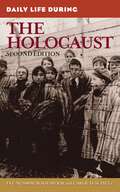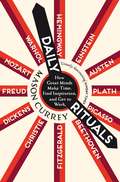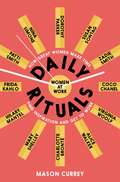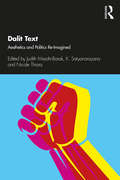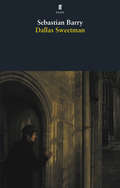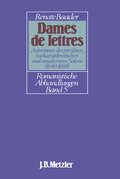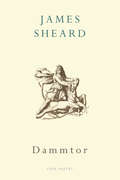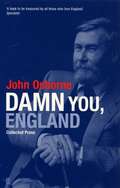- Table View
- List View
The Daily Henry James: A Year of Quotes from the Work of the Master (A Year of Quotes)
by Henry JamesA strange and delightful memento of one of the most lasting literary voices of all time, The Daily Henry James is a little book from a great mind. First published with James’s approval in 1911 as the ultimate token of fandom—a limited edition quote-of-the-day collection titled The Henry James Year Book—this new edition is a gift across time, arriving as we mark the centenary of his death. Drawing on the Master’s novels, essays, reviews, plays, criticism, and travelogues, The Daily Henry James offers a series of impressions (for if not of impressions, of what was James fond?) to carry us through the year. From the deepest longings of Isabel Archer to James’s insights in The Art of Fiction, longer seasonal quotes introduce each month, while concise bits of wisdom and whimsy mark each day. To take but one example: Isabel, in a quote from The Portrait of a Lady for September 30, muses, “She gave an envious thought to the happier lot of men, who are always free to plunge into the healing waters of action.” Featuring a new foreword by James biographer Michael Gorra as well as the original introductions by James and his good friend William Dean Howells, this long-forgotten perennial calendar will be an essential bibelot for James’s most ardent devotees and newest converts alike, a treasure to be cherished daily, across all seasons, for years, for ages to come.
The Daily Henry James: A Year of Quotes from the Work of the Master (A Year of Quotes)
by Henry JamesA strange and delightful memento of one of the most lasting literary voices of all time, The Daily Henry James is a little book from a great mind. First published with James’s approval in 1911 as the ultimate token of fandom—a limited edition quote-of-the-day collection titled The Henry James Year Book—this new edition is a gift across time, arriving as we mark the centenary of his death. Drawing on the Master’s novels, essays, reviews, plays, criticism, and travelogues, The Daily Henry James offers a series of impressions (for if not of impressions, of what was James fond?) to carry us through the year. From the deepest longings of Isabel Archer to James’s insights in The Art of Fiction, longer seasonal quotes introduce each month, while concise bits of wisdom and whimsy mark each day. To take but one example: Isabel, in a quote from The Portrait of a Lady for September 30, muses, “She gave an envious thought to the happier lot of men, who are always free to plunge into the healing waters of action.” Featuring a new foreword by James biographer Michael Gorra as well as the original introductions by James and his good friend William Dean Howells, this long-forgotten perennial calendar will be an essential bibelot for James’s most ardent devotees and newest converts alike, a treasure to be cherished daily, across all seasons, for years, for ages to come.
The Daily Henry James: A Year of Quotes from the Work of the Master (A Year of Quotes)
by Henry JamesA strange and delightful memento of one of the most lasting literary voices of all time, The Daily Henry James is a little book from a great mind. First published with James’s approval in 1911 as the ultimate token of fandom—a limited edition quote-of-the-day collection titled The Henry James Year Book—this new edition is a gift across time, arriving as we mark the centenary of his death. Drawing on the Master’s novels, essays, reviews, plays, criticism, and travelogues, The Daily Henry James offers a series of impressions (for if not of impressions, of what was James fond?) to carry us through the year. From the deepest longings of Isabel Archer to James’s insights in The Art of Fiction, longer seasonal quotes introduce each month, while concise bits of wisdom and whimsy mark each day. To take but one example: Isabel, in a quote from The Portrait of a Lady for September 30, muses, “She gave an envious thought to the happier lot of men, who are always free to plunge into the healing waters of action.” Featuring a new foreword by James biographer Michael Gorra as well as the original introductions by James and his good friend William Dean Howells, this long-forgotten perennial calendar will be an essential bibelot for James’s most ardent devotees and newest converts alike, a treasure to be cherished daily, across all seasons, for years, for ages to come.
The Daily Henry James: A Year of Quotes from the Work of the Master (A Year of Quotes)
by Henry JamesA strange and delightful memento of one of the most lasting literary voices of all time, The Daily Henry James is a little book from a great mind. First published with James’s approval in 1911 as the ultimate token of fandom—a limited edition quote-of-the-day collection titled The Henry James Year Book—this new edition is a gift across time, arriving as we mark the centenary of his death. Drawing on the Master’s novels, essays, reviews, plays, criticism, and travelogues, The Daily Henry James offers a series of impressions (for if not of impressions, of what was James fond?) to carry us through the year. From the deepest longings of Isabel Archer to James’s insights in The Art of Fiction, longer seasonal quotes introduce each month, while concise bits of wisdom and whimsy mark each day. To take but one example: Isabel, in a quote from The Portrait of a Lady for September 30, muses, “She gave an envious thought to the happier lot of men, who are always free to plunge into the healing waters of action.” Featuring a new foreword by James biographer Michael Gorra as well as the original introductions by James and his good friend William Dean Howells, this long-forgotten perennial calendar will be an essential bibelot for James’s most ardent devotees and newest converts alike, a treasure to be cherished daily, across all seasons, for years, for ages to come.
The Daily Jane Austen: A Year of Quotes (A Year of Quotes)
by Jane AustenIt is a truth universally acknowledged that Jane Austen is eminently, delightfully, and delectably quotable. This truth goes far beyond the first line of Pride and Prejudice, which has muscled out many other excellent sentences. So many gems of wit and wisdom from her novels deserve to be better known, from Northanger Abbey on its lovable, naive heroine—“if adventures will not befal a young lady in her own village, she must seek them abroad”—to Persuasion’s moving lines of love from its regret-filled hero: “You pierce my soul. I am half agony, half hope. Tell me not that I am too late.” Devoney Looser, a.k.a. Stone Cold Jane Austen, has drawn 378 genuine, Austen-authored passages from across the canon, resulting in an anthology that is compulsively readable and repeatable. Whether you approach the collection on a one-a-day model or in a satisfying binge read, you will emerge wiser about Austen, if not about life. The Daily Jane Austen will amuse and inspire skeptical beginners, Janeite experts, and every reader in between by showcasing some of the greatest sentences ever crafted in the history of fiction.
The Daily Jane Austen: A Year of Quotes (A Year of Quotes)
by Jane AustenIt is a truth universally acknowledged that Jane Austen is eminently, delightfully, and delectably quotable. This truth goes far beyond the first line of Pride and Prejudice, which has muscled out many other excellent sentences. So many gems of wit and wisdom from her novels deserve to be better known, from Northanger Abbey on its lovable, naive heroine—“if adventures will not befal a young lady in her own village, she must seek them abroad”—to Persuasion’s moving lines of love from its regret-filled hero: “You pierce my soul. I am half agony, half hope. Tell me not that I am too late.” Devoney Looser, a.k.a. Stone Cold Jane Austen, has drawn 378 genuine, Austen-authored passages from across the canon, resulting in an anthology that is compulsively readable and repeatable. Whether you approach the collection on a one-a-day model or in a satisfying binge read, you will emerge wiser about Austen, if not about life. The Daily Jane Austen will amuse and inspire skeptical beginners, Janeite experts, and every reader in between by showcasing some of the greatest sentences ever crafted in the history of fiction.
The Daily Jane Austen: A Year of Quotes (A Year of Quotes)
by Jane AustenIt is a truth universally acknowledged that Jane Austen is eminently, delightfully, and delectably quotable. This truth goes far beyond the first line of Pride and Prejudice, which has muscled out many other excellent sentences. So many gems of wit and wisdom from her novels deserve to be better known, from Northanger Abbey on its lovable, naive heroine—“if adventures will not befal a young lady in her own village, she must seek them abroad”—to Persuasion’s moving lines of love from its regret-filled hero: “You pierce my soul. I am half agony, half hope. Tell me not that I am too late.” Devoney Looser, a.k.a. Stone Cold Jane Austen, has drawn 378 genuine, Austen-authored passages from across the canon, resulting in an anthology that is compulsively readable and repeatable. Whether you approach the collection on a one-a-day model or in a satisfying binge read, you will emerge wiser about Austen, if not about life. The Daily Jane Austen will amuse and inspire skeptical beginners, Janeite experts, and every reader in between by showcasing some of the greatest sentences ever crafted in the history of fiction.
The Daily Jane Austen: A Year of Quotes (A Year of Quotes)
by Jane AustenIt is a truth universally acknowledged that Jane Austen is eminently, delightfully, and delectably quotable. This truth goes far beyond the first line of Pride and Prejudice, which has muscled out many other excellent sentences. So many gems of wit and wisdom from her novels deserve to be better known, from Northanger Abbey on its lovable, naive heroine—“if adventures will not befal a young lady in her own village, she must seek them abroad”—to Persuasion’s moving lines of love from its regret-filled hero: “You pierce my soul. I am half agony, half hope. Tell me not that I am too late.” Devoney Looser, a.k.a. Stone Cold Jane Austen, has drawn 378 genuine, Austen-authored passages from across the canon, resulting in an anthology that is compulsively readable and repeatable. Whether you approach the collection on a one-a-day model or in a satisfying binge read, you will emerge wiser about Austen, if not about life. The Daily Jane Austen will amuse and inspire skeptical beginners, Janeite experts, and every reader in between by showcasing some of the greatest sentences ever crafted in the history of fiction.
Daily Life During the Holocaust (The Greenwood Press Daily Life Through History Series)
by Eve Nussbaum Soumerai Carol D. SchulzThe Holocaust—one of the most horrific examples of man's inhumanity to man in recorded history—resulted in the genocide of millions of people, most of them Jews. This volume explores the daily lives of the Holocaust victims and their heroic efforts to maintain a normal existence under inhumane conditions. Readers will learn about the effects of pogroms, Jewish ghettoes, Nazi rule, and deportation on everyday tasks like going to school, practicing religion, or eating dinner. Chapters on life in the concentration camps describe the incomprehensible conditions that plagued the inmates and the ways in which they managed to survive. Soumerai, a survivor herself, offers a unique perspective on the events. Coverage also includes accounts of resistance and the role of rescuers. Four new chapters explore current human rights abuses, including Holocaust denials, modern genocide, and human trafficking, enabling readers to contrast present and past events. In addition to a timeline, a glossary, and engaging illustrations, the second edition also features an extensive bibliography and resource center that guides student researchers toward web sites, organizations, films, and books on the Holocaust and other human rights abuses.Primary source testimonies from survivors provide powerful insight into the devastating effects of Nazi rule on people's lives. Soumerai, a survivor herself, offers a unique perspective on the events and insight into the persecution of non-Jews: Gypsies, gays, clergy who protested or protected victims, Communists, Jehovah's Witnesses, the mentally ill and handicapped. Readers will explore the effects of pogroms, Jewish ghettoes, Nazi rule, and deportation on everyday tasks like going to school, practicing religion, or eating dinner. Chapters on life in the concentration camps describe the incomprehensible conditions within the camps, including the ways in which inmates managed to survive: avoiding the infirmary, rationing food, utilizing the market system to trade for goods and clothing. Four new chapters shed a modern light on the events of the Holocaust, exploring human rights abuses that continue even today, including Holocaust Denials; genocide in Cambodia, Rwanda, and Sudan; and child slavery and human trafficking. The new material allows readers to compare and contrast present and past human rights abuses, exploring what lessons we have learned, if any, from the Holocaust. An expanded bibliography and resource center guides readers toward related web sites, organizations, films and books related to the Holocaust, modern-day slavery and genocide, child soldiers, and related human rights topics. Illustrations, a timeline of events and a glossary of terms are also included, making this a comprehensive resource for student researchers.
Daily Life During the Holocaust (The Greenwood Press Daily Life Through History Series)
by Eve Nussbaum Soumerai Carol D. SchulzThe Holocaust—one of the most horrific examples of man's inhumanity to man in recorded history—resulted in the genocide of millions of people, most of them Jews. This volume explores the daily lives of the Holocaust victims and their heroic efforts to maintain a normal existence under inhumane conditions. Readers will learn about the effects of pogroms, Jewish ghettoes, Nazi rule, and deportation on everyday tasks like going to school, practicing religion, or eating dinner. Chapters on life in the concentration camps describe the incomprehensible conditions that plagued the inmates and the ways in which they managed to survive. Soumerai, a survivor herself, offers a unique perspective on the events. Coverage also includes accounts of resistance and the role of rescuers. Four new chapters explore current human rights abuses, including Holocaust denials, modern genocide, and human trafficking, enabling readers to contrast present and past events. In addition to a timeline, a glossary, and engaging illustrations, the second edition also features an extensive bibliography and resource center that guides student researchers toward web sites, organizations, films, and books on the Holocaust and other human rights abuses.Primary source testimonies from survivors provide powerful insight into the devastating effects of Nazi rule on people's lives. Soumerai, a survivor herself, offers a unique perspective on the events and insight into the persecution of non-Jews: Gypsies, gays, clergy who protested or protected victims, Communists, Jehovah's Witnesses, the mentally ill and handicapped. Readers will explore the effects of pogroms, Jewish ghettoes, Nazi rule, and deportation on everyday tasks like going to school, practicing religion, or eating dinner. Chapters on life in the concentration camps describe the incomprehensible conditions within the camps, including the ways in which inmates managed to survive: avoiding the infirmary, rationing food, utilizing the market system to trade for goods and clothing. Four new chapters shed a modern light on the events of the Holocaust, exploring human rights abuses that continue even today, including Holocaust Denials; genocide in Cambodia, Rwanda, and Sudan; and child slavery and human trafficking. The new material allows readers to compare and contrast present and past human rights abuses, exploring what lessons we have learned, if any, from the Holocaust. An expanded bibliography and resource center guides readers toward related web sites, organizations, films and books related to the Holocaust, modern-day slavery and genocide, child soldiers, and related human rights topics. Illustrations, a timeline of events and a glossary of terms are also included, making this a comprehensive resource for student researchers.
Daily Rituals: How Great Minds Make Time, Find Inspiration, and Get to Work
by Mason Currey'Utterly fascinating' Daisy Goodwin, Sunday TimesBenjamin Franklin took daily naked air baths and Toulouse-Lautrec painted in brothels. Edith Sitwell worked in bed, and George Gershwin composed at the piano in pyjamas. Freud worked sixteen hours a day, but Gertrude Stein could never write for more than thirty minutes, and F. Scott Fitzgerald wrote in gin-fuelled bursts - he believed alcohol was essential to his creative process. From Marx to Murakami and Beethoven to Bacon, Daily Rituals by Mason Currey presents the working routines of more than a hundred and sixty of the greatest philosophers, writers, composers and artists ever to have lived. Whether by amphetamines or alcohol, headstand or boxing, these people made time and got to work.Featuring photographs of writers and artists at work, and filled with fascinating insights on the mechanics of genius and entertaining stories of the personalities behind it, Daily Rituals is irresistibly addictive, and utterly inspiring.
Daily Rituals: Women at Work
by Mason CurreyThe much-anticipated follow-up to the acclaimed and resoundingly fascinating Daily Rituals.Filled with the innovative, inspiring and wonderfully prolific accounts of some of the world's best female creators, Daily Rituals: Women at Work is the powerful and championing sequel to Mason Currey's first book, Daily Rituals. Barbara Hepworth sculpted outdoors and Janet Frame wore earmuffs as she worked to block out noise. Kate Chopin wrote with her six children ‘swarming around her’ whereas the artist Rosa Bonheur filled her bedroom with the sixty birds that inspired her work. Louise May Alcott wrote so vigorously – skipping sleep and meals – that she had to learn to write with her left hand to give her cramped right hand a break.Filled with details of the large and small choices these women made, Daily Rituals: Women at Work is about the day-to-day lives of some of the world’s most extraordinary creative minds who, whether Virginia Woolf, Charlotte Brontë, Nina Simone or Jane Campion, found the time and got to work.'An admirably succinct portrait of some distinctly uncommon lives' Meryle Secrest
Dalit Cosmos: Understanding Caste, Marginalisation and Dalit Literature in India
by Mudnakudu ChinnaswamyThis book is a fierce argument against social and caste discrimination in India, especially untouchability and emphatic call for social justice. Written by a first-generation Kannada Dalit writer, the book provides an insider’s view of caste discrimination as the author has lived through and experienced it. It traces the roots of present-day activism against caste discrimination, the influence of Ambedkar, the rise of Hindutva, and the role of Dalit literatures in shaping discourses around caste in India. An invigorating collection of essays and speeches by Mudnakudu Chinnaswamy, this volume will be of great interest to scholars and researchers of discrimination, literature, politics and political philosophy, exclusion studies, race, social justice, cultural studies, and South Asian studies.
Dalit Cosmos: Understanding Caste, Marginalisation and Dalit Literature in India
by Mudnakudu ChinnaswamyThis book is a fierce argument against social and caste discrimination in India, especially untouchability and emphatic call for social justice. Written by a first-generation Kannada Dalit writer, the book provides an insider’s view of caste discrimination as the author has lived through and experienced it. It traces the roots of present-day activism against caste discrimination, the influence of Ambedkar, the rise of Hindutva, and the role of Dalit literatures in shaping discourses around caste in India. An invigorating collection of essays and speeches by Mudnakudu Chinnaswamy, this volume will be of great interest to scholars and researchers of discrimination, literature, politics and political philosophy, exclusion studies, race, social justice, cultural studies, and South Asian studies.
Dalit Counter-publics and the Classroom: A Sharmila Rege Reader
by Uma Chakravarti V. GeethaThis book is an anthology of the collected essays of Sharmila Rege (1964 – 2013) that addresses themes to do with pedagogy and culture. Rege makes a compelling argument for rethinking the content of sociological knowledge and invokes in this context, Anticaste radical philosophies, associated with Mahatma Phule and Babasaheb Ambedkar as well as the writings of Dalit women. Equally, she seeks to rethink and engender the domain of Cultural Studies. She calls attention to 'Dalit counter-publics', comprising performance and commemorative traditions that are committed to ending the caste order and argues for a critical rethinking of the relationship between caste, sexuality, and popular culture.Framed and annotated by an introduction that places Sharmila's work in the intellectual and historical contexts that shaped it, the volume also features short prefatory notes by her colleagues on the various themes taken up for discussion. Addressing, as it does, the researcher, the activist and the teacher, the book is indispensable for students and researchers of Women’s Studies, feminism, gender studies, Dalit Studies, minority studies, Sociology, Cultural Studies, Performance Studies, as well as studies in language and rhetoric.
Dalit Counter-publics and the Classroom: A Sharmila Rege Reader
This book is an anthology of the collected essays of Sharmila Rege (1964 – 2013) that addresses themes to do with pedagogy and culture. Rege makes a compelling argument for rethinking the content of sociological knowledge and invokes in this context, Anticaste radical philosophies, associated with Mahatma Phule and Babasaheb Ambedkar as well as the writings of Dalit women. Equally, she seeks to rethink and engender the domain of Cultural Studies. She calls attention to 'Dalit counter-publics', comprising performance and commemorative traditions that are committed to ending the caste order and argues for a critical rethinking of the relationship between caste, sexuality, and popular culture.Framed and annotated by an introduction that places Sharmila's work in the intellectual and historical contexts that shaped it, the volume also features short prefatory notes by her colleagues on the various themes taken up for discussion. Addressing, as it does, the researcher, the activist and the teacher, the book is indispensable for students and researchers of Women’s Studies, feminism, gender studies, Dalit Studies, minority studies, Sociology, Cultural Studies, Performance Studies, as well as studies in language and rhetoric.
Dalit Literatures in India
by Joshil K. Abraham Judith Misrahi-BarakThis book breaks new ground in the study of Dalit literature, including in its corpus a range of genres such as novels, autobiographies, pamphlets, poetry, short stories and graphic novels. With contributions from major scholars in the field, alongside budding ones, the book critically examines Dalit literary production and theory. It also initiates a dialogue between Dalit writing and Western literary theory. This second edition includes a new Introduction which takes stock of developments since 2015. It discusses how Dalit writing has come to play a major role in asserting marginal identities in contemporary Indian politics while moving towards establishing a more radical voice of dissent and protest. Lucid, accessible yet rigorous in its analysis, this book will be indispensable for scholars and researchers of Dalit studies, social exclusion studies, Indian writing, literature and literary theory, politics, sociology, social anthropology and cultural studies.
Dalit Literatures in India
by Joshil K. Abraham Judith Misrahi-BarakThis book breaks new ground in the study of Dalit literature, including in its corpus a range of genres such as novels, autobiographies, pamphlets, poetry, short stories and graphic novels. With contributions from major scholars in the field, alongside budding ones, the book critically examines Dalit literary production and theory. It also initiates a dialogue between Dalit writing and Western literary theory. This second edition includes a new Introduction which takes stock of developments since 2015. It discusses how Dalit writing has come to play a major role in asserting marginal identities in contemporary Indian politics while moving towards establishing a more radical voice of dissent and protest. Lucid, accessible yet rigorous in its analysis, this book will be indispensable for scholars and researchers of Dalit studies, social exclusion studies, Indian writing, literature and literary theory, politics, sociology, social anthropology and cultural studies.
Dalit Text: Aesthetics and Politics Re-imagined
by Judith Misrahi-Barak K. Satyanarayana Nicole ThiaraThis book, companion to the much-acclaimed Dalit Literatures in India, examines questions of aesthetics and literary representation in a wide range of Dalit literary texts. It looks at how Dalit literature, born from the struggle against social and political injustice, invokes the rich and complex legacy of oral, folk and performative traditions of marginalised voices. The essays and interviews systematically explore a range of literary forms, from autobiographies, memoirs and other testimonial narratives, to poems, novels or short stories, foregrounding the diversity of Dalit creation. Showcasing the interplay between the aesthetic and political for a genre of writing that has ‘change’ as its goal, the volume aims to make Dalit writing more accessible to a wider public, for the Dalit voices to be heard and understood. The volume also shows how the genre has revolutionised the concept of what literature is supposed to mean and define. Effervescent first-person accounts, socially militant activism and sharp critiques of a little-explored literary terrain make this essential reading for scholars and researchers of social exclusion and discrimination studies, literature (especially comparative literature), translation studies, politics, human rights and culture studies.
Dalit Text: Aesthetics and Politics Re-imagined
by K. Satyanarayana Judith Misrahi-Barak Nicole ThiaraThis book, companion to the much-acclaimed Dalit Literatures in India, examines questions of aesthetics and literary representation in a wide range of Dalit literary texts. It looks at how Dalit literature, born from the struggle against social and political injustice, invokes the rich and complex legacy of oral, folk and performative traditions of marginalised voices. The essays and interviews systematically explore a range of literary forms, from autobiographies, memoirs and other testimonial narratives, to poems, novels or short stories, foregrounding the diversity of Dalit creation. Showcasing the interplay between the aesthetic and political for a genre of writing that has ‘change’ as its goal, the volume aims to make Dalit writing more accessible to a wider public, for the Dalit voices to be heard and understood. The volume also shows how the genre has revolutionised the concept of what literature is supposed to mean and define. Effervescent first-person accounts, socially militant activism and sharp critiques of a little-explored literary terrain make this essential reading for scholars and researchers of social exclusion and discrimination studies, literature (especially comparative literature), translation studies, politics, human rights and culture studies.
Dallas Sweetman
by Sebastian BarryFrom his grave in the precincts of Canterbury Cathedral, Dallas Sweetman is called to give account. He tells a story of love and death, jealousy and miraculous happenings, of the divided loyalties of Protestants and Catholics in the Elizabethan Age. Before us, his judges, Dallas seeks to justify the actions of his life. But is he telling the truth? And can he be forgiven? The lost tradition of staging new plays at Canterbury Cathedral, most famously T. S. Eliot's Murder in the Cathedral, was revived with the premiere of Sebastian Barry's Dallas Sweetman in September 2008.
La dama de las camelias
by Alejandro DumasInspirándose en un personaje real, dibujó Alexandre Dumas (hijo) a «la dama de las camelias», una de las heroínas más seductoras de toda la literatura romántica, cuya «expresión virginal, incluso infantil» sobrenada en medio de su vida cortesana. El verdadero drama empieza cuando un respetable joven burgués se enamore de ella y ella decida aceptarlo.
Dammtor
by James SheardDammtor is the old city gate and now the centre of ground transport for the great port of Hamburg. In James Sheard's second collection it is a 'station for midnights, hitched up on stone legs, hollow with sunken light' - a hub for the damaged and deracinated. These precise, wounded poems draw the reader through this desolate landscape - through sexual longing, sexual violence, bereavement and the beginning of hope through the birth of a son.Dammtor restlessly narrates the condition of maleness, looking for truth and music in a voice which is both urgent and unadorned. The poems are spoken in solitary places - late-night stations, hotel lobbies, car rides and empty woodland - but they are addressed to the living, the missing, the dead and the just-born. Personal and political narratives leak into the spaces of the poems to form a strange light which has something of the hallucinatory clarity of translations. The voice might be by turn elegaic, vicious, obsessive or bewildered as it explores its topic, but it is accompanied by an eye which will not - or, perhaps, cannot - blink. Finding tenderness amid brutality, Dammtor is a highly accomplished and remarkable collection.
Damn You England: Collected Prose
by John OsborneWell-known playwright and acerbic wit, John Osborne was a man of trenchant opinions which he was unafraid to express. Ranging from his infamous 1961 letter to Tribune which provides the book with its title to columns written in the last decade of his life, the prose on offer here bear witness to the rage, fury - and great tenderness - that inspired so much of his work.



